State funding formula among top issues at Harrisburg
BY DEBORAH BOWERS, Editor & Publisher
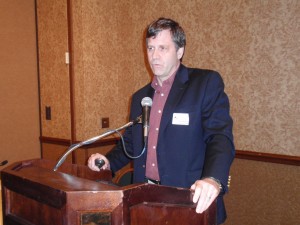
Tom Daniels speaks to PFPA about the state program's funding formula
HARRISBURG, PA – The formula that determines how much money the state sends to localities for farmland preservation was one of the hot topics discussed among Pennsylvania’s county-level farmland program administrators at the semi-annual conference of the Pa. Farmland Preservation Association (PFPA) May 18.
The topic was among those named by University of Pennsylvania planning Professor Tom Daniels as aspects of Pennsylvania’s program that needed adjustment after more than 20 years of program operation. Daniels, former Lancaster County program director, was a featured speaker at the conference.
Also addressing the group was Pa. Secretary of Agriculture George Greig. Greig, speaking just

Secretary of Agriculture George Greig with PFPA officers
hours after his swearing in, said he believed in farmland preservation and while serving on the Crawford County Conservation District Board urged county government to establish its farmland preservation program in the early years of the state program. Greig told the group that he will do what he can to protect and to increase program funding. Greig’s own farm in Crawford County is not preserved due to lack of development pressure in the area, Greig told FPR.
Tom Daniels, who received a certificate of appreciation from the group for his leadership in the policy and practice of farmland preservation both locally and nationally, said the funding formula used in Pennsylvania was rewarding counties that have high development pressure and stronger real estate transfer tax revenues, resulting in high per-acre costs. He said the state’s agriculture would better benefit from a formula that emphasizes a county’s percent of state agricultural output and its financial commitment to the program.
The state’s more productive agricultural counties are being left in the cold when it comes to amount of funds awarded, Daniels indicated.
Ellen Dayhoff, veteran program administrator for Adams County, said she agreed with Daniels and that a look at where her county stands in ag production and what it received from the state compared to Allegheny County was a good example of the problem. Adams ranks 6th in the state
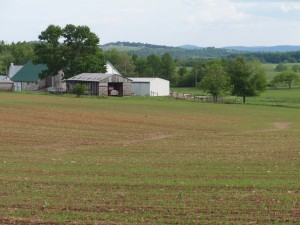
Adams County farmland (FPR photo)
for total market value of agricultural products and 1st in fruit production, but it received a 2010 state grant of just $117,814 based on the county’s portion of state Realty Transfer Tax revenues. It also received a state match of $306,457, an award for the county’s own contribution of $425,015, for total state funds of $448,842.
Comparing those figures with those of Allegheny County, tells the tale, Dayhoff said: Allegheny ranks 56th in the state for total market value of agricultural products and 13th in vegetable production, its highest ranking, but it received a 2010 state grant of $671,095 based on the county’s portion of state Realty Transfer Tax revenues. Allegheny received zero matching funds, because the county contributed zero dollars to the effort.
Dayhoff said the example shows clearly how the formula rewards counties that are undistinguished agriculturally, and don’t contribute funding to the effort, but are rewarded for having larger numbers of real estate transactions. Those real estate sales could be due to less effective planning and development restrictions, resulting in weaker farmland protection.
Northampton County program administrator Maria Bentzoni agreed the state funding formula could be adjusted. “Now that we’re 20 years out, isn’t it time to revisit the allocation formula?”
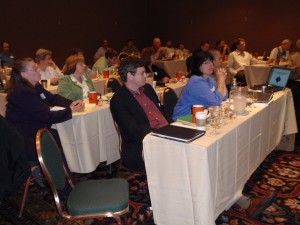 The way farms are ranked, or prioritized, was also a topic. Patricia McCandless of York County said the percent of emphasis in the ranking formula given for soil productivity is too high at 40 percent for her county, but Betty Reefer said she felt it was just right for Westmoreland County.
The way farms are ranked, or prioritized, was also a topic. Patricia McCandless of York County said the percent of emphasis in the ranking formula given for soil productivity is too high at 40 percent for her county, but Betty Reefer said she felt it was just right for Westmoreland County.
Daniels said he felt that weighting soil productivity in the ranking formula should be left up to the counties and not set by the state.
Daniels also said preserving contiguous blocks of farmland was an important strategy for a program to succeed in retaining agriculture.
“If you’re not going to get large preserved blocks of farmland, you’re not going to succeed. The last thing you want is development coming in next to your preserved farm.” He also urged administrators to pursue enactment of growth boundaries around townships as a means of protecting contiguous blocks of preserved farmland and showed examples from Lancaster County. Another key to success is farmer support and satisfaction with the program, which will help build contiguous blocks.
“Farmland preservation works when you have neighbors talking to neighbors, talking to neighbors,” Daniels said.

Ray Pickering, agricultural development director for Fauquier County, Va.
The group’s theme for the meeting, “Back to the Future” also brought former Pa. state program director Ray Pickering to present his current work as agricultural development director for Fauquier County, Va. Fauquier’s farmland preservation program, begun in 2002, has preserved 7,380 acres on 36 farms, and retired 390 development rights from its target farms consisting of traditional dairy and crop farms. The program uses a set $25,000 per development right, and has four criteria for eligibility, including a 50-acre size requirement, recognition as a “boni fide agricultural operation,” agricultural zoning designation, and absence of other easements or restrictions, which effectively excludes those properties which have donated conservation easements.
Fauquier County has more than 69,000 acres on about 464 properties preserved through easements donated to the Virginia Outdoors Foundation. Many of those properties are equine operations in the county’s northeastern area nearest to Loudoun County’s rural western region. Pickering answered many questions about farmland preservation in Virginia, which has little support from the state level compared to other states. Programs that have managed to use points-based appraisal systems or other systems like Fauquier’s, which avoid the timely and costly appraisal process were of particular interest to the group.
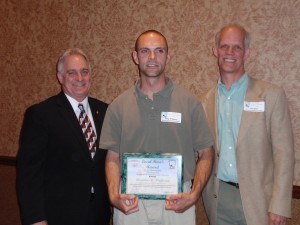
Doug Wolfgang with Agriculture Secretary Greig and Jim Baird of American Farmland Trust
At the meeting Doug Wolfgang, director of the Pa. Bureau of Farmland Preservation, was feted with the group’s Local Hero Award for his leadership and effective administration of the state program.
Wolfgang said other important topics for the group include gas drilling, which brought a number of comments from administrators who asked Wolfgang to provide guidance on how to monitor farms that have gas leases or company rights-of-way. Betty Reefer of Westmoreland County said most preserved farms have signed leases with gas drilling companies. Wolfgang said that owners of preserved farms who grant a right of way for the pipelines are not in violation of state ag easements.
Wolfgang said that while companies drilling for natural gas in the western and northern portions of the state are, as local officials say, “breathing new life into an ailing farm economy,” he wonders whether the presence of compressor stations will harm the image of the program for the rest of the state.
Agricultural conservation easements used by the Pennsylvania Bureau of Farmland Preservation, and most other state farmland programs, do not prohibit mineral extraction, and the boom in Marcellus shale drilling throughout western and northern Pennsylvania and southern New York has put hundreds of preserved farm owners in position to sign gas leases and program administrators in some counties confirmed that many if not all of their preserved farms have signed leases. One thing is more than evident: the money to be made from natural gas extraction has cut regulation to the quick. Water quality concerns are the focus, as the content of wastewater, which in Pennsylvania is being trucked off site and processed at wastewater facilities, is still under study. The EPA is studying the effects of hydraulic fracturing, but that report will not be completed for another year. Truck accidents and spillage have already occurred.
The Pennsylvania legislature may amend Act 43, which governs the farmland preservation program, to deal with the gas drilling issue. But amendment language is far from final and the earliest any changes could be introduced would be next fall, according to Senate staff.
Jeff Everett takes post at Wisconsin NRCS
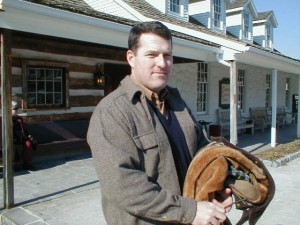
Everett (Photo by FPR)
MADISON, WI – Jeff Everett has become easement programs coordinator for the Wisconsin state office of the NRCS as of early May. Everett had served as farmland preservation program administrator for Carroll County, Md. for three and a half years. In his new post Everett is responsible for administering all farm bill easement programs including the Farm and Ranchlands Protection Program for the state.
While at Carroll County, Everett devised a new method for installment purchases of conservation easements and set a national record for number of acres preserved in a county PDR program in a single year by preserving more than 5,000 acres in 2010. His finance innovation, which provided increased interest payments and potential for tax benefits in exchange for a discounted principal, saved millions of dollars for the county. He also successfully instituted conservation practices as part of conservation easement agreements.
While at Carroll County, Everett garnered several awards, including national recognition from The Conservation Fund for his innovative finance work.
“I currently administer all farm bill easement programs for NRCS, so it’s a mix of farmland preservation and natural resource conservation. While I miss home, it is refreshing to experience a new locale, particularly in a place as progressive as Madison. I was able to preserve 12,000 acres in the three and a half years I was in Carroll County, which is something I’m proud of, particularly since it occurred during the worse economic recession since the Great Depression.”
Everett hails from Virginia where his parents have a farm in Shenandoah County. He formerly managed the Howard County, Md., PDR program and also worked for the National Park Service in New Hampshire. Everett continues to work as a consultant to help build potential for a PDR program in New Hampshire and also provided consulting services to state and local officials in Virginia.
New Jersey announces largest preservation deal in state history
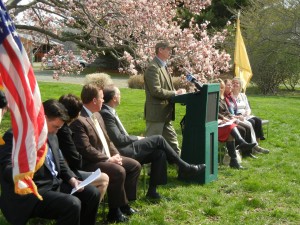
Property owner Bill Flemer speaks at the announcement that his family has agreed to place its 1,900 acres into open space and farmland preservation
TRENTON, NJ – New Jersey land preservation efforts saw several milestones last month , including marking its 2000th preserved farm and announcing a deal that will preserve a group of contiguous properties comprising 1,900 acres in nursery use for decades. The deal includes both fee and easement transactions and is the largest in the state’s history.
During a news conference April 18, New Jersey Agriculture Secretary Douglas Fisher and Dept. of Environmental Protection (DEP) Commissioner Bob Martin joined officials from Monmouth, Mercer, and Burlington counties, Upper Freehold Township, and the Monmouth Conservation Foundation, as well as local officials, to announce contracts with members of the Flemer family, which until recently operated the land as Princeton Nurseries, once one of the nation’s largest commercial nurseries.
The $28 million project includes $11.4 million for agricultural conservation easements on about 900 acres. About 15,000 acres of farmland are preserved within a five-mile radius of the parcels that comprise the project. Open space fee purchases will use $16.4 million, according to Hope Gruzlovic of the State Agriculture Development Committee (SADC), which administers the state farmland preservation programs. More than 1,000 acres will be preserved as open space, creating a 512-acre State Wildlife Management Area and nearly 500 acres of additions to an adjacent county park and greenway corridor. The SADC worked with the DEP Green Acres Program to bring the project forward.
“This project is in the midst of what already is the highest concentration of preserved farmland in the state, and for good reason — the farmland here has extraordinarily high-quality soil, among the best in New Jersey,” said Secretary Fisher.

One of the nursery properties preserved as part of the 1,900-acre open space and farmland project
As the project was announced, the Green Acres Program celebrated its 50th anniversary.
The majority of the land is in Upper Freehold in Monmouth County, with additional parcels in Hamilton Township in Mercer County and North Hanover Township in Burlington County. Monmouth County is providing more than $10 million for the project — $7 million toward the purchase of open space for county parkland additions, and in cooperation with Upper Freehold another $4.6 million toward the purchase of farmland easements.
The Flemer family stated that the preservation of the land was the fulfillment of a lifetime wish of John Flemer who began the Princeton Nursery over 50 years ago.
“We are grateful to our staff and to our customers for all those good years and to the State of New Jersey for ensuring that this land we love will keep its rural character and natural beauty forever.”
“The scope of this project is impressive,” said Monmouth Conservation Foundation Executive Director Adele Keller. “Having the largest unpreserved farming operation in Monmouth County contiguous to many preserved farms and open space areas is of great significance to our communities.”
The SADC celebrated preserving 2000 farms since it began operating in 1985. The celebration took place at the 102-acre Tark farm in Salem County, which was among the recent preservation projects that helped the state Farmland Preservation Program reach the 2,000-farm mark. The New Jersey Conservation Foundation worked closely with co-owner Ernest Tark Jr.
To date, about 190,000 acres of farmland have been preserved under the state program in 18 counties. Salem County has preserved 28,000 acres, more than any other county.
Bailey returning to Ohio farmland preservation post
BY DEBORAH BOWERS, Editor & Publisher
REYNOLDSBURG, OH – Michael Bailey was named May 9 to head Ohio’s farmland preservation program, a position he held from 2004 to 2007 before becoming executive director of the Ohio Livestock Care Standards Board. Bailey will continue in that position as well, according to a press release.

Mike Bailey
The Ohio programs Bailey will be responsible for include the Clean Ohio Agricultural Easement Purchase Program, the Ohio Agricultural Easement Donation Program, and the Ohio Agricultural Security Area Program.
Bailey joined his counterparts from other states in 2007 for the first Farmland Preservation Roundtable in Gettysburg, Pa., organized by Farmland Preservation Report. Ohio was not represented at the most recent Roundtable held in Annapolis, Md.
Bailey’s immediate task includes getting through the purchase program’s current application round that ended April 6. Funded through bonds voters approved in 2008, the round brought in 190 applications representing 28,500 acres. The program also convenes an annual statewide Farmland Preservation Summit.
In 2010, the Ohio program added 6,160 acres at a cost of $6.2 million. The total preserved agricultural acres to date is about 42,400, comprising purchased easements and 6,000 acres of donated agricultural conservation easements. The figure also includes close to 3,000 acres comprising 19 farms that were preserved in 2002 using tobacco settlement funds.
Bailey replaces Kristen Jensen.
The big transition
BY TOM DANIELS, Senior Contributing Editor
Preserving farmland –signing easements, handing out checks, and putting blobs of “forever green” on maps—is the fun part of the process. Yet, with public budgets under stress and private land trusts struggling to fill the gap, this is a good time to assess the future of farmland preservation.
Six states (PA, MD, NJ, CO, VT, and DE) have exceeded 100,000 acres preserved through government-funded programs. These states also now hold or co-hold nearly 10,000 farmland easements. Although the acquisition of conservation easements will continue to be a major focus of these programs, monitoring and enforcing easements will become the top priority. Monitoring and enforcement require governments to maintain a dedicated staff or else to contract out with a third party to do at least some of the work. I am reluctant to recommend the contracting option—especially when enforcement is needed—because a central purpose of a conservation easement deal is to develop a long-term relationship based on trust between the landowner and the easement holder. But I understand that governments may not want to hire staff to monitor easements because of the costs of benefits. Still, governments will be better served, both in accountability and transparency, if their own employees are interacting with the landowners.
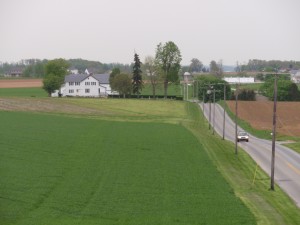
Lancaster County farm (FPR photo)
On the other hand, contracting out for monitoring can save money for a public program. For example, the Lancaster County (PA) Agricultural Preserve Board has contracted with the Lancaster Farmland Trust to monitor about one third of its more than 700 easements each year. The cost of monitoring may not increase much over time on a per farm basis, but a big fear among land preservationists is an expensive enforcement case. The Land Trust Alliance is responding to this challenge by arranging for easement insurance for land trusts– in essence a defense fund—to ensure that a legal challenge does not bankrupt or financially damage a land trust. A land trust will pay a few thousand dollars a year for easement insurance.
It is uncertain when public officials will authorize increases in farmland preservation budgets. The economy remains sluggish, and the real estate market has hardly begun to recover. Ironically, this is an ideal time to preserve land. The difference between market values and the value of land under an easement has narrowed. Many developers are looking to unload land, if not take a bargain sale easement offer.
Public preservation programs and land trusts have to decide how much funding to allocate to land and easement acquisitions and how much to monitoring and enforcement. But going forward, monitoring and enforcement will eat up a larger piece of the funding pie. That will be the price of land preservation success.
Former Md. Gov. Glendening says strong ag is essential to smart growth
BY BOB HEUER, Contributing Editor
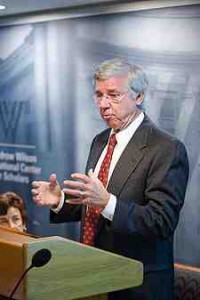
Parris Glendening, who was a University of Maryland professor for 27 years, speaking on smart growth in 2006 (Wikipedia photo)
Buy-in from farmland owners on suburbia’s edge can accelerate efforts to create compact, walkable communities in metropolitan regions nationwide. So says Parris Glendening, president of Smart Growth America’s Leadership Institute. This Washington-based non-profit agency helps local governments implement strategies that target housing and transportation investment near jobs, shops and schools.
Stable urban-edge farm economies will encourage urban reinvestment by acting as a market-based firewall to impede suburbia’s outward march, according to Glendening—a national leader for smart growth during two terms as governor of Maryland, serving from 1995 to 2003.
The Glendening administration created a number of innovative incentives for local governments to encourage more compact patterns of development. Maryland’s Rural Legacy Program, one of Glendening’s most successful programs, has preserved large blocks of agricultural and natural land. Less successful was a law that targeted state assistance to “priority funding areas”—i.e. urbanizing locales that met smart growth criteria.
“I used to say the best tool against sprawl is a prosperous agricultural community,” Gov. Glendening recalls. “People who are opposed to sprawl often don’t understand the importance of farmers remaining economically viable. And the ag community was often hostile towards smart growth. They view their land as their own IRA and want to protect their right to the very logical alternative of selling for development.”
Maryland’s initiatives helped boost local farm economies by expanding both the supply and demand for farmers markets products. Yet, the focus on environmental outcomes like open space and habitat protection sparked a political impasse.
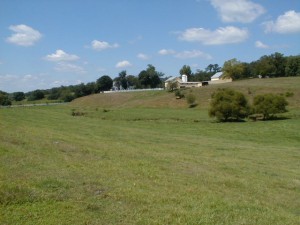
Maryland farm preserved through the Rural Legacy Program (FPR photo)
Gov. Glendening sees potential for a “a new kind of conversation” emanating from the nationwide movement to know the source of food. Unmet consumer demand for local food creates comparative advantages for farmers near population centers and, thus, a strong economic rationale for a comprehensive policy framework that promotes farmland preservation and agricultural development.
The Leadership Institute is affiliated with Smart Growth America—a national advocacy organization that supports farmland preservation as a means to encourage reinvestment in “existing” urban and suburban communities. Gov. Glendening says both organizations need to do a better job of recognizing exurban farming areas as another “existing” community in need of reinvestment: “We have some partners involved in agriculture and rural development but haven’t made this connection as explicit as we should.”
This myopia is reflected in the Obama Administration’s Sustainable Communities Initiative—a partnership between HUD, DOT and EPA. In FY 2011, Congress appropriated $70 million for HUD-administered regional planning grants to help guide state, metropolitan, and local investments in land use, transportation and housing.
The lion’s share of the funds goes to metropolitan planning organizations (MPOs). For decades, MPOs have treated urban-edge agriculture as a temporary land use pending inevitable suburbanization. Some MPOs—such as those in Philadelphia, Sacramento and Columbus—are beginning to explore ways to sustain their regional agriculture industries.
A more typical example is the Chicago Metropolitan Agency for Planning. CMAP recently received a $4 million HUD grant to support implementation of its 2040 Plan for northeastern Illinois. CMAP’s idea for “sustainable communities” acknowledges that maybe farmland isn’t empty space best paved over. Indeed, the plan recommendation to “promote sustainable local food” is a historic point of departure reflecting the recognition that agriculture as an enduring asset. Urban, suburban and exurban constituencies are beginning to target parcels of underutilized private and publicly owned land for local food production and related businesses.
But local food is a sliver of the region’s agricultural market segments. In CMAP’s seven-county planning jurisdiction, farming occupies a land mass about six times the size of the city of Chicago. The decisions of northeastern Illinois farmland owners and renters affect all aspects of regional planning—ranging from transportation, land use and housing to the natural environment, economic growth, and community development. Yet, CMAP has never had a strategy to encourage proactive dialogue with the agricultural industry.
“As issues of food costs and sustainability become more urgent, it is more essential than ever that the smart growth and the agriculture communities recognize that we are two sides of one equation,” Gov. Glendening says. “We all lose when farmers come under financial stress or live with the constant impact of sprawl. When farmers prosper, it helps the prosperity of our existing cities and towns. This must be the heart of an ongoing conversation about America’s future.”